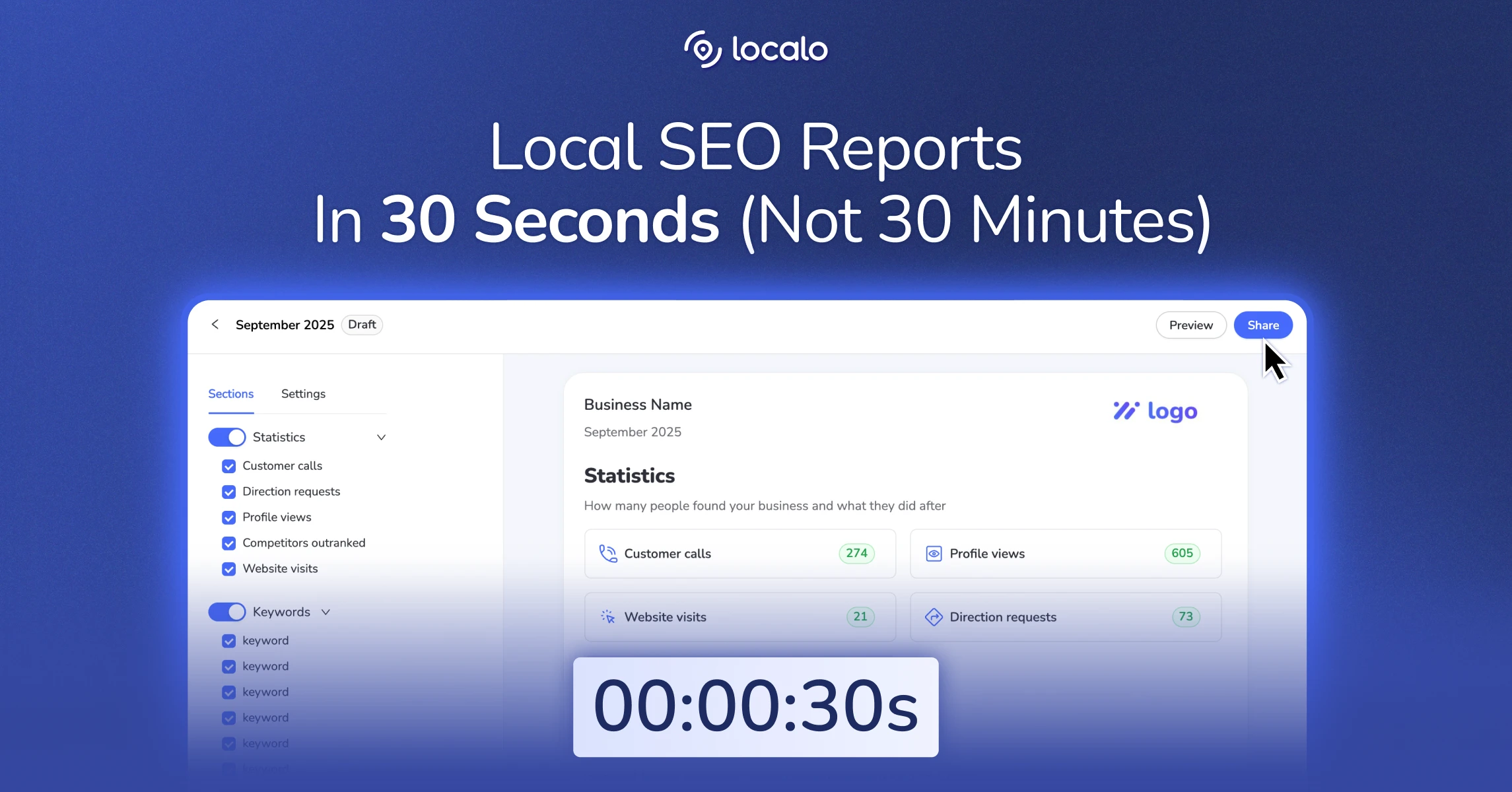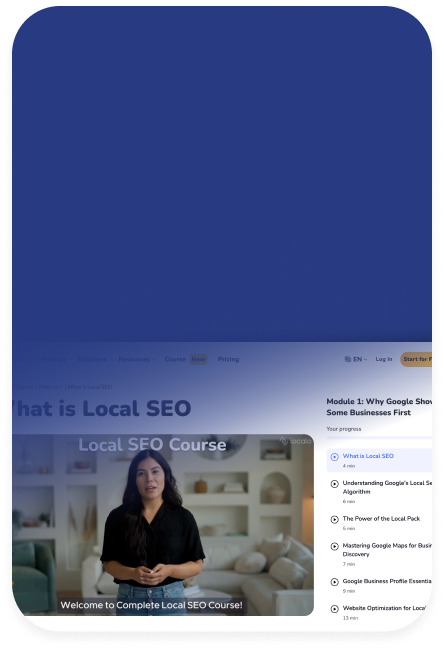Some time ago, I tried to find solid research on something we all struggle with: client reporting in local SEO. We wanted answers to basic questions like ‘How much time should reports really take?’ or ‘Do clients actually read what we send them?’
Here’s what we found: almost nothing reliable.
No major research has studied this. No independent surveys with real methodology. Just Reddit discussions and agencies quoting each other’s blog posts.
For something that sits at the center of how we communicate with clients, that’s surprising.
What Agencies and Local SEO Specialists Tell Me About Reporting
I talk to agency owners and local SEO specialists managing multiple clients all the time. When we discuss reporting, the conversation always comes back to the same pain point.
Time investment: 15-30 minutes per client per month, plus ad hoc requests that take additional time.
And that’s just how much they spend on compiling data, not on analyzing what the numbers mean, writing clear, jargon-free explanations, or taking the calls. Just taking screenshots, exporting data, and formatting everything to look professional.
The math isn’t friendly for those without solid templates or automation. If you work with 20 clients, you spend 5-10 hours a month just gathering data.
One agency told me they wanted to use Localo for everything local SEO, but couldn’t until we added automatic reporting: ‘We’re waiting for automatic reports. Not operationally feasible until this exists.’ It stuck with me because it wasn’t about wanting good-looking reports. It was about operational maintenance.
The Real Problem: Communication, Not Creation
Databox surveyed over 300 agencies about client collaboration. What they found reveals the actual challenge.
Half of the entire reporting time goes toward two things: analyzing what happened and why (30%) and explaining the data to clients (20%). Another 18% gets spent writing recommendations for next steps.
Think about this. If you spend 15-30 minutes creating a report, you’re spending the same amount of time again just explaining what those numbers mean. That’s creating work that requires more work.
The communication gap is real.
Your client runs a restaurant. They understand their business perfectly. They don’t understand why ‘position 4 in the local pack’ matters for their revenue or what ‘citation NAP consistency’ means for getting more customers.
The problem isn’t that your clients don’t care about results. They absolutely do. The problem is that standard reporting templates were designed for agencies, not for the business owners receiving them.
Here’s what I know from my experience working with thousands of Google Business Profiles and business owners behind them: Clients who don’t understand your work can’t defend it. When budgets get tight, they can’t justify the investment, especially when it takes several months to see tangible SEO results.
This is exactly why Localo Reports starts from a different foundation.
Local SEO Reporting That Keeps Clients
The agency world has been optimizing reports without knowing if format matters, how much time it should cost, or what clients need to trust your work. Don’t get me wrong, this isn’t criticism. It’s reality when working in an unmeasured space where everyone’s making educated guesses about what’s ‘good.’
Reports that matter aren’t the ones with the prettiest charts. They’re the ones that help clients understand why your work matters, trust that you know what you’re doing, and explain your value to others who control budgets.
No tool automatically creates that. But the right tool gives you time to build it.
Before you even think about automation, let’s make sure you’re not already making these mistakes. We see these everywhere, and they’re killing client trust.
Three Reporting Mistakes I See Everywhere
Check if you’ve fallen for these traps, even as an experienced agency:
Sending reports without context - A PDF, presentation, or spreadsheet of metrics alone forces clients to schedule calls just to understand what they paid for. Context should be built into the report format, not added later via phone.
Only showing results, not activities - Clients who see ‘Rankings improved’ without seeing ‘We published 12 posts, responded to 8 reviews, and fixed 23 citations’ can’t connect your work to outcomes. Show both.
Making every fluctuation look urgent - Local rankings shift daily based on search location, time, and Google’s real-time calculations. If every small change triggers a red flag, clients panic unnecessarily. Save the red for actual problems.
There are three immediate improvements you can make to any reporting process:
- Answer the three questions first: ‘What did we do?’ ‘Is this working?’ and ‘What’s next?’ before adding metrics.
- Add one-sentence context to every metric: Next to ‘Position 4’ write ‘Up from 12 and appearing in top results when customers search.’
- Include your activity with results : Show ‘8 posts published’ right next to ‘Profile views increased 34%’ so clients see an immediate connection between actions and outcomes.
That manual approach works. It just doesn’t scale when you’re managing 30+ clients.
Not sure which metrics actually matter for local businesses? I wrote a complete guide to local SEO metrics that walks through everything from the three foundation numbers (calls, directions, website clicks) to advanced analytics. It’ll help you decide what belongs in your reports and what’s just noise.
So, here’s what we built to give you that time back.
We built Reports based on direct feedback from agencies like yours who told us manual reporting was blocking growth. Here’s how it works:

See how Localo Reports works →
Each report automatically shows what you did AND what happened because of it. Activities (exact counts of posts, photos, review responses, citations) sit right next to results (ranking changes with position maps, profile statistics showing calls and direction requests, competitor analysis). Your clients finally see the connection.

Educational content explains what business owners are seeing in plain language. You can toggle sections on and off, show only progress to reduce client anxiety about natural ranking fluctuations, and add your own notes that Localo remembers for next time.

Everything generates as a draft first. Just check, adjust if needed, and send via email, PDF, or link. Your logo appears at the top, your custom message is included, and it goes to the recipients you specified.

If you reduce reporting to just 30 seconds per client per month for 20 of them, you’d go from 5-10 hours down to just 10 minutes.
That’s the difference between spending 1-2 full workdays on reporting versus getting it all done during a coffee break. That kind of automation would free up a ton of time to actually grow those accounts or take on more.
We can prove we save you time. What you do with that time makes the difference.
Built From Your Feedback, Not Guessing
We opened this article admitting there’s no solid research on what makes client reporting effective. So we did what we should: we listened to you.
The agency that told us ‘not operationally feasible until this exists’ needed time back. The freelancers managing 30+ clients needed bulk controls. The specialists spending too much time explaining needed reports that business owners could actually understand.
Here’s what Reports in Localo look like:
- 30-second report generation, so operational maintenance is not even a question
- Auto-reports scheduling, so your expertise guides strategy, not business as usual
- Educational content in plain language, so clients need fewer meetings to understand metrics
- Delivery options , so you can personalize the client experience on all stages
- Reports Manager for bulk control, so 50 clients don’t require 50 individual processes
What clients understand and trust? That’s the work only you can do. We just give you the time to do it.

Article author:
Sebastian Żarnowski
Co-founder & CEO
I have been involved in local marketing for years, starting my career at KS Agency, where I also initiated the Local SEO department. Currently, as a co-founder of Localo, I am developing a tool that helps local businesses reach their customers. I share my knowledge through blogs, webinars, social media, and YouTube videos. I focus on authenticity, a practical approach, and effectiveness to support the growth of local businesses and help them connect with their customers more effectively. I value unconventional thinking and am constantly seeking new solutions in marketing.










